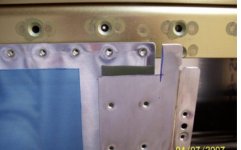Hello Fellow builders
Building my first experimental RV7A and i made the mistake of prepping and dimpling wing skins before scarfing the lap joints
Found a suggestion to trim inboard skin similar to the trim on the bottom of the skin?
Trimming means it will sit flush with the tank skin but means trimming the skin just below the spar?
Thanks in advance for any guidance
Ok maybe I wasn’t very clear my apologies. My question is can i trim the inboard skin just below the rear spar so that the lap joint at the top of the skin is very similar to the way it joins at the rear spar
There are a number of posts where people have done this rather then scarf the joint
See pic which explains way better than me.
Jason
Building my first experimental RV7A and i made the mistake of prepping and dimpling wing skins before scarfing the lap joints
Found a suggestion to trim inboard skin similar to the trim on the bottom of the skin?
Trimming means it will sit flush with the tank skin but means trimming the skin just below the spar?
Thanks in advance for any guidance
Ok maybe I wasn’t very clear my apologies. My question is can i trim the inboard skin just below the rear spar so that the lap joint at the top of the skin is very similar to the way it joins at the rear spar
There are a number of posts where people have done this rather then scarf the joint
See pic which explains way better than me.
Jason
Attachments
Last edited:





